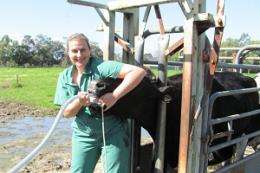Lameness in dairy cattle linked to diet

The results of 'on farm' research into the deadly cattle condition ruminal acidosis could help dairy farmers detect the early warning signs and prevent stock loss.
Ruminal acidosis is a metabolic disorder affecting the pH balance in the rumen resulting from the ingestion of large amounts of feed rich in fermentable carbohydrates like grain, starchy by-products like potatoes and bread, and lush good quality pasture.
Murdoch University dairy medicine lecturer Elizabeth Bramley says the results are exciting because researchers developed and applied a model which linked lameness to acidosis.
The finding gives farmers an indicator that the disease could be present in their herd and an opportunity to take preventative measures.
"We found that herds with a high prevalence of lameness had a significantly higher risk – 103 per cent – of acidosis," Dr Bramley says.
"This is important because lameness is a significant problem in the Australasian dairy industry and there has been much debate as to the importance of nutrition in causing lameness.
"Once farmers understand the potential risk factors for the disease and are able to identify possible 'warning signs' of a problem, they can use strategies to reduce the risk in their individual herds like strategic feeding of fibre, addition of dietary additives and feed management changes."
Dr Bramley says it became very apparent when she was conducting the research that many farmers who had a significant problem with acidosis in their herd did not realise it.
"Since then, Dairy Australia have done a great job of education and increasing awareness of the problem in Australia through farmer and advisor publications.
"I think this needs to continue, particularly as farmers are feeding more grain/concentrate and better quality pasture with a higher sugar content and lower fibre."
Dr Bramley describes the study as one of the first epidemiological studies to systematically examine the association between differences in rumen function, reflecting acidosis and disease in dairy cows.
They tested rumen fluid, blood and faeces from 800 cattle from 100 dairy herds in five regions of New South Wales and Victoria.
The results have been published in the New Zealand Veterinary Journal.
Dr Bramley says at the time of the study, ruminal acidosis had been researched using experimental models both in Australia and overseas but there were no 'on-farm' studies looking at large numbers of animals reported.
"We felt there was a need to define the disease in Australian dairy herds and to investigate how significant a problem it was in the industry."
More information: www.ncbi.nlm.nih.gov/pubmed/23844638
Provided by Science Network WA



















